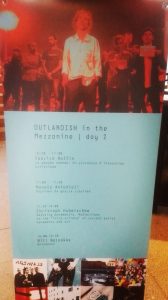Anybody who stands still in a forward-moving crowd is just as big a hindrance as if he moved against the crowd. (Robespierre in Büchner’s Danton’s Death)
The paper “Refusing movement/s. Reflections on the ‘intra-actions’ of current social movements and art” was presented at the DARE (Deleuze and Artistic Research) Conference 2015 in Ghent. Here in this blogpost you can find the abstract of the talk as well as the Video of the full presentation.
A longer German version of this paper was published in Polylog, for more information see this Post.
Abstract
On 17 June 2013, the very day the Turkish government prohibited demonstrations in Istanbul in reaction to the occupation of Gezi Park, Erdem Gündez, a Turkish artist and activist, became, what is now known as one of the most prominent “figures” of the Gezi Park movement, namely the “standing man.” Simply standing in the middle of Taksim square, facing the Atatürk Cultural Centre, not moving, not shouting, not doing anything but standing there for hours. At first his presence went unnoticed, but after some time more and more people not only were interested but also joined Gündez until the police banished them from the square and arrested a number of people. The “standing man” was a performance as well as a political act, criticising the prohibition of demonstrations, demonstrating without actually “demonstrating” in a classical way. Similar to Bartleby’s “I would prefer not to” the “standing man” refuses to move. Sharing a similar immobility with many characters in Beckett’s work, the standing man also creates a territory, changing the space around him; “in their trash can or on their bench, Beckett’s characters stake out a territory” (Deleuze and Guattari 1987, 503). Like a standing wave or a wheel that turns so fast it looks as though it does not turn at all, the “standing man” is characterised by intensity and not by speed or extensity.
until the police banished them from the square and arrested a number of people. The “standing man” was a performance as well as a political act, criticising the prohibition of demonstrations, demonstrating without actually “demonstrating” in a classical way. Similar to Bartleby’s “I would prefer not to” the “standing man” refuses to move. Sharing a similar immobility with many characters in Beckett’s work, the standing man also creates a territory, changing the space around him; “in their trash can or on their bench, Beckett’s characters stake out a territory” (Deleuze and Guattari 1987, 503). Like a standing wave or a wheel that turns so fast it looks as though it does not turn at all, the “standing man” is characterised by intensity and not by speed or extensity.
The activists squatting public squares do something very similar. In building tents, in actually living on the square, they don’t follow the rules set by the government; they don’t behave as they are told to. They are not passengers, passing the street; rather, they stand still and therefore block traffic and disturb the public policy, thereby staking out a territory. Again their actions are not characterised by speed but rather by intensity, as showcased by a slogan the Spanish 15M movement created: “We’re going slow, because we’re going far.” Modifying this slogan one could propose: we’re refusing movement, because we are a movement.
In the first part of my paper I will discuss the “standing man” and other artistic projects and their manifold “intra-actions” (Barad and Kleinmann 2012) with social movements. Drawing on these artistic practices as processes of intensity—a resisting and at the same time creative force—I will argue against current popular theories of acceleration, which promote speed over intensity. In the second part I want to explore the shared processes of “fabulation” in the “intra-actions” of political art and political practices and to what degree these fabulations are nonutopian attempts to constitute what Deleuze calls “the people to come.”
Creating not only new modes of thinking but also new modes of acting politically, art plays an important role in current social movements and the creation of new strategies of protest. As Deleuze states in the famous interview with Toni Negri: “Art is resistance.”
References
- Barad, Karen, and Adam Kleinmann. 2012. “Intra-actions”. Karen Barad interviewed by Adam Kleinmann. Mousse 34: An issue about dOCUMENTA 13, 9 June: 76–81. Also available at www.academia.edu/1857617/_Intra-actions_Interview_of_Karen_Barad_by_Adam_Kleinmann.
- Deleuze, Gilles, and Félix Guattari. 1987. A Thousand Plateaus: Capitalism and Schizophrenia. Translated by Brian Massumi. Minneapolis: University of Minnesota Press.
[…] « Refusing movement/s — Paper at DARE-Conference Perecs Text-Maschine » […]
Everything is very open with a precise description of
the issues. It was truly informative. Your site is useful.
Many thanks for sharing!